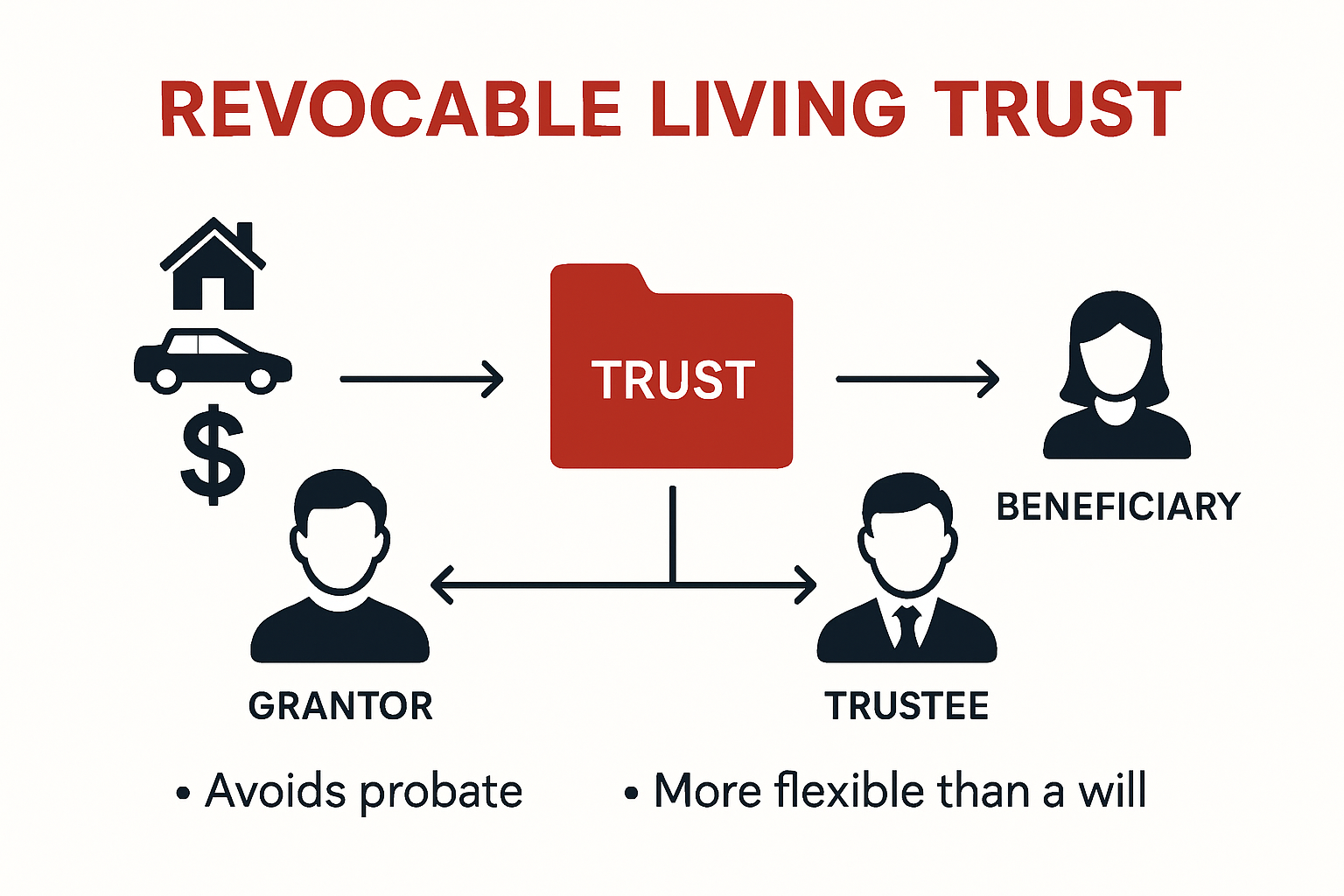
PARENTS & HOMEOWNERS: MY 7-STEP ESTATE PLANNING PROCESS WILL PROTECT YOUR HEIRS
From Creditors, Predators & Bad Choices, And Will Help You Become a (Bigger) Hero to Your Family!



Revocable Living Trusts for Families in California 2025
Estate planning in California has always come with headaches, but now families are facing even more hurdles as state laws and property values keep shifting. Here is what might surprise you. The probate process in California can eat up 3 to 7 percent of your estate’s value and drag on for over a year. Most people assume wills are enough, but families who rely only on a will could end up losing more money and privacy than they ever expected.
Table of Contents
- What Are Revocable Living Trusts?
- Why California Families Need A Trust In 2025
- Protecting Children And Wealth From Risk
- Steps To Set Up A Revocable Living Trust
Quick Summary
| Takeaway | Explanation |
|---|---|
| Importance of Revocable Living Trusts | Revocable living trusts provide California families a flexible method for managing assets, allowing for modifications and avoiding the probate process, thus ensuring smoother asset transitions. |
| Need for Strategic Estate Planning | In 2025, California families face unique financial challenges such as high property values and complex laws, making strategic estate planning critical for wealth preservation and management. |
| Protecting Beneficiaries | Trusts can include conditions for asset distribution, ensuring immature beneficiaries receive structured support rather than overwhelming wealth, fostering responsible financial management. |
| Asset Protection | Incorporating provisions in trusts can shield assets from creditors and unforeseen legal issues, making it crucial for families to establish effective risk management strategies. |
| Steps for Trust Setup | Families should conduct an asset inventory, select trustees, and properly execute and fund the trust, with professional guidance recommended to comply with legal requirements. |
What Are Revocable Living Trusts?
California families seeking comprehensive estate protection have a powerful tool at their disposal: revocable living trusts. These legal arrangements provide a flexible and strategic approach to managing assets during life and after death. Learn more about protecting your family’s assets.

Understanding the Basic Structure
A revocable living trust is a legal document that allows individuals to transfer ownership of their assets into a trust while maintaining complete control during their lifetime. According to Cornell Law School, this arrangement enables the grantor to modify, change, or completely revoke the trust at any time. Unlike traditional wills, revocable living trusts offer a dynamic solution for asset management that adapts to changing life circumstances.
The trust typically involves three key parties: the grantor (who creates the trust), the trustee (who manages the assets), and the beneficiaries (who will ultimately receive the assets). In many cases, especially for California families, the grantor serves as both the initial trustee and the primary beneficiary, ensuring maximum flexibility and control over their assets.
Key Advantages for California Families
Revocable living trusts provide significant benefits that make them particularly attractive for California property owners. FindLaw highlights that these trusts are especially valuable in avoiding the complex and costly probate process typical in California. By transferring assets into a trust, families can ensure a smoother, more private transfer of property without the public scrutiny and lengthy court proceedings associated with traditional estate settlement.
However, it is crucial to understand the limitations. While revocable living trusts offer tremendous planning advantages, they do not automatically provide asset protection from creditors or reduce estate taxes. The assets remain part of the grantor’s taxable estate, meaning careful tax planning is still essential. Families should view these trusts as a strategic component of a comprehensive estate plan, not a complete solution to all financial planning challenges.
The primary strength of a revocable living trust lies in its adaptability. Families can modify the trust as their life circumstances change – adding or removing assets, changing beneficiaries, or adjusting distribution terms. This flexibility makes revocable living trusts an invaluable tool for California families looking to maintain control while creating a clear, efficient path for asset transfer and family financial protection.
To clarify the distinctive benefits and limitations of revocable living trusts compared to wills, see the comparison table below.
| Feature | Revocable Living Trust | Will |
|---|---|---|
| Avoids Probate | Yes | No |
| Privacy | Yes, generally private | No, public record |
| Flexibility to Modify | Yes, easily modified/revoked | Somewhat; requires formal changes |
| Asset Protection from Creditors | No (during grantor’s life) | No |
| Asset Control During Incapacity | Yes | No |
| Tax Benefits | No automatic reduction | No |
| Costs | Higher initial cost | Lower initial cost |
Why California Families Need a Trust in 2025
California families face unique financial complexities that make establishing a revocable living trust more critical than ever in 2025. With escalating property values, complex family dynamics, and evolving legal landscapes, strategic estate planning has become essential for protecting generational wealth. Explore comprehensive trust strategies for California families.
Navigating California’s Complex Legal Terrain
California’s legal environment presents significant challenges for families seeking to preserve and transfer assets. According to California Continuing Education of the Bar, the state’s probate process is notoriously complex and expensive, often consuming 3-7% of an estate’s total value and potentially taking 9-18 months to complete. A revocable living trust offers a strategic alternative, allowing families to bypass these lengthy and costly court proceedings.
Moreover, California’s community property laws add another layer of complexity to estate planning. Married couples must carefully consider how assets acquired during marriage are categorized and distributed. A well-structured revocable living trust can provide clarity and protection, ensuring that both separate and community property are managed according to the family’s precise wishes.
Protecting Family Wealth in an Uncertain Economic Climate
The economic landscape of 2025 demands proactive wealth preservation strategies. California Estate Planning Resources emphasizes that revocable living trusts offer unprecedented flexibility in managing assets during unexpected life events. This is particularly crucial in California, where property values and personal wealth can fluctuate dramatically.
For families with significant assets, a trust provides multiple layers of protection. It allows for seamless asset management if a primary breadwinner becomes incapacitated, ensures privacy by keeping estate details out of public court records, and provides a clear mechanism for asset distribution without judicial intervention. This is especially important for high-net-worth families who want to minimize public exposure and maintain control over their financial legacy.
Additionally, California families must consider the potential for future legal and tax changes. A revocable living trust offers the unique advantage of being modifiable, allowing families to adapt their estate plan as legal and financial circumstances evolve. This flexibility is invaluable in a state known for its dynamic regulatory environment and complex tax structure.
The trust becomes particularly powerful for families with complex situations – those with blended families, business owners, or those with special needs dependents. By carefully structuring a revocable living trust, families can create precise instructions for asset distribution, establish protective mechanisms for vulnerable family members, and ensure their wishes are followed exactly, regardless of unexpected life challenges.
Ultimately, a revocable living trust in 2025 is more than a legal document – it’s a comprehensive family protection strategy. It provides peace of mind, financial flexibility, and a clear path for preserving and transferring wealth across generations in California’s complex and ever-changing landscape.
Protecting Children and Wealth From Risk
Parents in California face unprecedented challenges in protecting their children’s financial future and preserving family wealth. A revocable living trust offers a strategic shield against potential risks, providing families with a powerful tool to safeguard their most valuable assets. Discover comprehensive asset protection strategies.
Controlling Inheritance and Protecting Immature Beneficiaries
One of the most critical advantages of a revocable living trust is the ability to implement nuanced inheritance protections. According to Lynk Law, parents can specify precise conditions for asset distribution, preventing young or financially inexperienced beneficiaries from receiving substantial wealth prematurely. This might include staggered distributions tied to specific life milestones such as completing higher education, reaching a certain age, or demonstrating financial responsibility.
For instance, a trust can be structured to provide educational funding, release partial distributions at specific ages (25, 30, 35), or even link inheritance to achievements like starting a business or pursuing advanced education. This approach ensures that children are not overwhelmed by sudden wealth but instead are guided towards financial maturity and responsible asset management.
Shielding Assets from Creditors and Legal Risks
California families face increasing financial uncertainties that can threaten generational wealth. California Elder Law highlights the importance of incorporating spendthrift clauses in living trusts. These provisions can protect beneficiaries’ inheritances from potential personal legal challenges, creditor claims, or divorce proceedings.
While revocable living trusts do not provide absolute asset protection during the grantor’s lifetime, they create significant barriers for potential creditors. By carefully structuring the trust, families can implement mechanisms that make it substantially more difficult for external parties to access inherited assets. This is particularly crucial for families with children in professions with high liability risks, such as medical practitioners, entrepreneurs, or professionals in litigation-prone industries.
Comprehensive Risk Management for Family Wealth
The California Attorney General’s office emphasizes the importance of proactive estate planning in avoiding probate complications. A revocable living trust provides a comprehensive approach to risk management that extends far beyond simple asset transfer. It allows families to create intricate protection mechanisms that adapt to changing family dynamics, potential legal challenges, and evolving financial landscapes.
This might include provisions for special needs children, protection against potential future marriages or divorces, and mechanisms to preserve family businesses or significant investment portfolios. The trust can include detailed instructions for asset management in case of the parents’ incapacity, ensuring continuous financial stability and protection for dependent children.
Ultimately, a revocable living trust represents more than a legal document – it is a sophisticated strategy for preserving family wealth, protecting children from financial vulnerabilities, and creating a lasting legacy of financial security. By anticipating potential risks and implementing proactive protective measures, California families can ensure their hard-earned assets remain safeguarded for future generations.
Steps to Set Up a Revocable Living Trust
Creating a revocable living trust is a strategic process that requires careful planning and precise execution. California families must approach this important legal document with thorough preparation and expert guidance. Discover how to protect your family’s assets effectively.
Comprehensive Asset Inventory and Documentation
The first critical step in establishing a revocable living trust involves conducting a meticulous inventory of all personal and family assets. According to Moravec’s Law, this process requires gathering detailed documentation for real estate, bank accounts, investments, retirement accounts, personal property, and any business interests. Families must create a comprehensive list that includes:
- Property deed information
- Bank account details
- Investment portfolio records
- Retirement account statements
- Vehicle titles
- Business ownership documents
- Personal property with significant value
This thorough documentation serves as the foundation for accurately transferring assets into the trust and ensures no valuable resources are overlooked during the estate planning process.
Below is a table outlining key asset categories to consider when preparing your inventory for a revocable living trust.
| Asset Category | Types of Documentation Needed |
|---|---|
| Real Estate | Property deeds |
| Bank Accounts | Account statements, account numbers |
| Investment Portfolios | Brokerage statements, account details |
| Retirement Accounts | Plan statements, beneficiary forms |
| Vehicles | Titles and registration documents |
| Business Interests | Ownership certificates, corporate docs |
| Valuable Personal Property | Appraisals, receipts, insurance records |
Selecting Trustees and Drafting Trust Parameters
California Attorney General’s Office emphasizes the importance of carefully selecting trustees and defining precise trust parameters. Most California families initially name themselves as primary trustees, maintaining complete control over their assets during their lifetime. The trust document must clearly outline:
- Successor trustee designations
- Specific instructions for asset management
- Beneficiary designations
- Conditions for asset distribution
- Provisions for potential incapacity scenarios
While it is technically possible to create a trust without legal assistance, consulting with an estate planning attorney is strongly recommended. Professional guidance ensures the trust complies with California’s specific legal requirements and accurately reflects the family’s unique circumstances and intentions.
Executing and Funding the Trust
The final stage of establishing a revocable living trust involves formal execution and comprehensive asset funding. This process requires more than simply drafting a document. Families must legally transfer asset ownership into the trust’s name, a process known as funding. Moravec’s Law recommends the following critical steps:
- Signing the trust document in front of a notary public
- Retitling assets in the trust’s name
- Updating beneficiary designations
- Maintaining detailed records of all transfers
- Regularly reviewing and updating the trust
It is crucial to understand that a trust is not a static document. Families should plan to review and potentially modify their trust periodically, especially after significant life events such as marriages, divorces, births, or substantial changes in financial circumstances.
The table below summarizes these key steps in the process of creating and funding a revocable living trust for California families.
| Step | Description |
|---|---|
| Asset Inventory | Catalog all assets and gather documentation |
| Draft Trust Document | Create trust terms with attorney guidance |
| Select Trustees | Choose primary and successor trustees |
| Execute Trust | Sign trust in presence of notary |
| Fund the Trust | Retitle assets and update beneficiary designations |
| Maintain and Review | Periodically review, update, and keep records |
By approaching the creation of a revocable living trust with diligence, strategic planning, and professional guidance, California families can establish a robust mechanism for protecting their assets, ensuring smooth wealth transfer, and providing long-term financial security for future generations.
Frequently Asked Questions
What is a revocable living trust?
A revocable living trust is a legal arrangement that allows individuals to transfer ownership of their assets into a trust while maintaining control over those assets during their lifetime. It can be modified or revoked at any time by the grantor.
Why do California families need a revocable living trust in 2025?
In 2025, California families face rising property values and complex estate laws, making revocable living trusts essential for avoiding costly probate, ensuring privacy, and providing flexibility in estate planning.
How does a revocable living trust protect children and immature beneficiaries?
A revocable living trust can set specific conditions for inheritance, such as staggered distributions based on age or milestones. This ensures that young or financially inexperienced beneficiaries receive support rather than overwhelming wealth all at once.
What are the steps to set up a revocable living trust in California?
To set up a revocable living trust, families should conduct a comprehensive inventory of assets, select trustees, draft the trust document, execute it in front of a notary, and fund the trust by transferring asset ownership into its name.
Secure Your Family’s Future with a Custom Living Trust
Are you worried about California’s expensive probate process and the risk of family disputes over your estate? The article pointed out how a revocable living trust can help you avoid long court delays, protect your privacy, and give you the control your family needs. At the Wills & Trusts section of the Law Offices of Eric Ridley, our approach is hands-on and personal. We help California families design strategic trusts that put your wishes first and shield your loved ones from unnecessary stress and legal complications.

Take action today to protect your assets and create peace of mind for your family. Start by learning more at https://ridleylawoffices.com or explore complete estate planning solutions tailored for your situation. Schedule your free consultation now so you can stay ahead of legal changes and secure your legacy the right way.
Recommended
- Types of Trusts in California: Protecting Family Wealth in 2025 – Law Office of Eric Ridley
- Living Trust vs Will in California: 2025 Guide for Families – Law Office of Eric Ridley
- How to Protect Your Assets with a Revocable Living Trust – Law Office of Eric Ridley
- Irrevocable Trust Definition: Estate Planning for California Families (2025) – Law Office of Eric Ridley
- Demystifying California Termination Laws You should Know!


